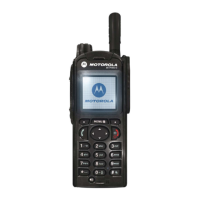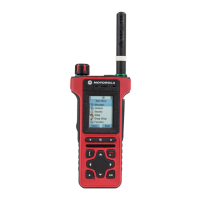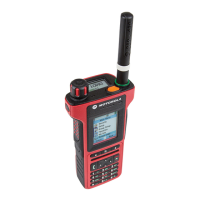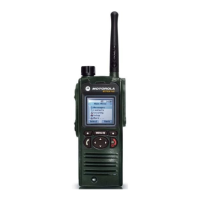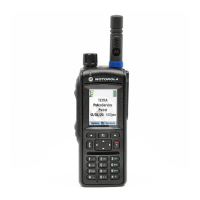Do you have a question about the Motorola MTP850 Ex and is the answer not in the manual?
Information on safe usage and RF exposure compliance.
EU directive on waste electrical and electronic equipment.
Motorola's rights regarding copyrighted computer programs.
Technical specifications like voltage, current, RF power, and temperature.
Explains graphic icons used for visual cues and warnings.
Explains notations and structure of the user guide.
Step-by-step instructions for inserting the battery.
Procedures and indicators for charging the device battery.
Guidelines for cleaning battery contacts and extending battery life.
Instructions for securely screwing the antenna onto the terminal.
Identifies and describes the terminal's physical buttons, keys, and ports.
Procedures for powering the terminal on/off and locking/unlocking the keypad.
Guidance on how to hold the terminal for different call types and audio settings.
Explains Trunked Mode Operation (TMO) and Direct Mode Operation (DMO).
Provides methods for switching between TMO and DMO modes.
Defines Group Calls and how talkgroups are organized and monitored.
Methods for selecting a talkgroup using various terminal features.
Settings for how groups are scrolled through via rotary knob or navigation key.
Step-by-step guide to initiating a TMO group call.
Describes direct mode communication without infrastructure.
Options for configuring gateway and repeater settings in DMO.
Initiating DMO group calls via MS-MS, Gateway, or Repeater.
Defines Private Calls as point-to-point communication between two individuals.
Procedures for initiating and answering private calls in TMO and DMO.
Explains calling landline or extension numbers.
Steps for initiating and receiving phone and PABX calls.
Overview of emergency modes available in TMO and DMO.
Key details regarding emergency button use and RF sensitive areas.
Specifics of emergency group and private calls in TMO.
Features of silent emergency operations with no audible indications.
Covers entering/exiting the browser, menu panes, and general navigation.
Guidance on creating bookmarks, hotkeys, and managing saved pages.
Explains accessing browsing history and utility tools.
Explains how GPS determines location and its potential applications.
Tips for maximizing GPS accuracy and signal reception.
How to turn GPS on/off and adjust accuracy settings.
Steps to access the GPS sub-menu for location services.
Displays calculated location information including time, latitude, and longitude.
Configuration options for balancing GPS accuracy and power consumption.
Procedures for accessing and moving through menu items.
Identifies menu icons and provides a hierarchical list of menu options.
Procedures for creating, deleting, and managing contact entries.
Options for keypad locking, encryption, and key validity checks.
Configuration settings for ring styles, volume, display, and data functions.
Accessing group setup, scanning, and 'My Groups' features.
Information on viewing sent/received data statistics and bandwidth status.
Overview of sending short text, status, and receiving messages.
Steps for sending messages, using templates, and managing inbox items.
How to access, read, and manage incoming messages in the inbox.
Information on receiving and managing call-out alerts.
Explains common terminal messages and their meanings.
Describes tones for idle states like returning home or coverage loss.
Explains tones for call waiting, data connection, and talk permit.
Tones related to volume settings, transmit inhibit, and low battery alerts.
Alphabetical listing of keywords and their corresponding page numbers.
Information on safe usage and RF exposure compliance.
EU directive on waste electrical and electronic equipment.
Motorola's rights regarding copyrighted computer programs.
Technical specifications like voltage, current, RF power, and temperature.
Explains graphic icons used for visual cues and warnings.
Explains notations and structure of the user guide.
Step-by-step instructions for inserting the battery.
Procedures and indicators for charging the device battery.
Guidelines for cleaning battery contacts and extending battery life.
Instructions for securely screwing the antenna onto the terminal.
Identifies and describes the terminal's physical buttons, keys, and ports.
Procedures for powering the terminal on/off and locking/unlocking the keypad.
Guidance on how to hold the terminal for different call types and audio settings.
Explains Trunked Mode Operation (TMO) and Direct Mode Operation (DMO).
Provides methods for switching between TMO and DMO modes.
Defines Group Calls and how talkgroups are organized and monitored.
Methods for selecting a talkgroup using various terminal features.
Settings for how groups are scrolled through via rotary knob or navigation key.
Step-by-step guide to initiating a TMO group call.
Describes direct mode communication without infrastructure.
Options for configuring gateway and repeater settings in DMO.
Initiating DMO group calls via MS-MS, Gateway, or Repeater.
Defines Private Calls as point-to-point communication between two individuals.
Procedures for initiating and answering private calls in TMO and DMO.
Explains calling landline or extension numbers.
Steps for initiating and receiving phone and PABX calls.
Overview of emergency modes available in TMO and DMO.
Key details regarding emergency button use and RF sensitive areas.
Specifics of emergency group and private calls in TMO.
Features of silent emergency operations with no audible indications.
Covers entering/exiting the browser, menu panes, and general navigation.
Guidance on creating bookmarks, hotkeys, and managing saved pages.
Explains accessing browsing history and utility tools.
Explains how GPS determines location and its potential applications.
Tips for maximizing GPS accuracy and signal reception.
How to turn GPS on/off and adjust accuracy settings.
Steps to access the GPS sub-menu for location services.
Displays calculated location information including time, latitude, and longitude.
Configuration options for balancing GPS accuracy and power consumption.
Procedures for accessing and moving through menu items.
Identifies menu icons and provides a hierarchical list of menu options.
Procedures for creating, deleting, and managing contact entries.
Options for keypad locking, encryption, and key validity checks.
Configuration settings for ring styles, volume, display, and data functions.
Accessing group setup, scanning, and 'My Groups' features.
Information on viewing sent/received data statistics and bandwidth status.
Overview of sending short text, status, and receiving messages.
Steps for sending messages, using templates, and managing inbox items.
How to access, read, and manage incoming messages in the inbox.
Information on receiving and managing call-out alerts.
Explains common terminal messages and their meanings.
Describes tones for idle states like returning home or coverage loss.
Explains tones for call waiting, data connection, and talk permit.
Tones related to volume settings, transmit inhibit, and low battery alerts.
Alphabetical listing of keywords and their corresponding page numbers.
| Frequency Range | 380-430 MHz |
|---|---|
| Keypad | Yes |
| Emergency Button | Yes |
| Man Down Alert | Yes |
| GPS | Yes |
| Bluetooth | Yes |
| ATEX/IECEx | Yes |
| Channel Spacing | 12.5 kHz |
| RF Power Output | 1W |
| Security | End-to-end encryption |
| Channels | 1000 |
| Encryption | TEA1, TEA2, TEA3 |
